Although three years earlier "SOS" had been adopted as
the international standard for distress calls, Marconi operators in 1909 were
generally still using "CQD," the distress call they had adopted in 1904. But the
rescue of the passengers of the Republic was the first major sea rescue where
radio played an important role, and it captured the imagination of the world.
Radio Broadcast, April, 1924, page 449:
C Q D
The Story of the First
Sea Rescue by Radio as Told by
Jack Binns Who Became a Radio Hero
in the Old Days when Radio Was
Wireless and a Ten-Inch Spark Coil
and a Magnetic Detector Was the
Ultimate in Apparatus
By ALFRED M. CADDELL
Serious
accidents on passenger liners at sea are rare enough these days. Just stop for
a moment and see if you can remember when the last great disaster at sea
occurred. The war years should not be counted, for the sinking of the
Lusitania, for example, was not due to faulty navigation or the luck o'
the sea.
The fact is
that radio has so aided navigation that real accidents simply don't happen.
Every big vessel is in constant touch with both shores of the ocean during the
entire passage, the ship's chronometers are corrected twice daily by radio
time signals, and the radio compass guides the big ships in time of fog or
heavy weather. The shore radio compass is available on almost every coast for
every ship, small or large.
We have grown to
take radio almost for granted, as far as its use in marine telegraphy goes.
The public expects great things of the radio now--and isn't disappointed. But
it was not so long ago that the radio waves had to prove their usefulness.
Then, even the big ships boasted but one operator who could be at his set only
a part of the day. Sets would not send very far, and the apparatus was not too
dependable. The public, if it gave much consideration to radio at all, was
somewhat skeptical.
But when radio saved
the lives of thousands at sea in January, 1909, when Jack Binns at the key of
the Republic, sent out distress calls which gave him the aid of the
land station nearest him and the many ships around the scene of the disaster,
Americans began to feel that maybe this radio thing had something to it after
all.
Jack Binns has
given me this fascinating story of the Republic himself, exactly as it
happened.--A. M. C.
IT WAS
four o'clock Saturday morning, January 23, 1909. The steamship Republic,
in command of Captain Inman Sealby, had left New York for Liverpool at five
o'clock the evening before, with 1,600 passengers on board. Jack Binns was the
one wireless operator on the ship. Almost immediately upon clearing Sandy Hook
the ship had run into a thick fog bank, and the automatic fog-horn was set
going. Binns was kept busy at the key until midnight, sending and receiving
commercial messages, and exchanging "location" reports with other ships and
stations on shore. And then he turned into his bunk for the night.
Like all ship operators Binns went to sleep with a
more or less alert mind. All went well until eight bells, and then---- 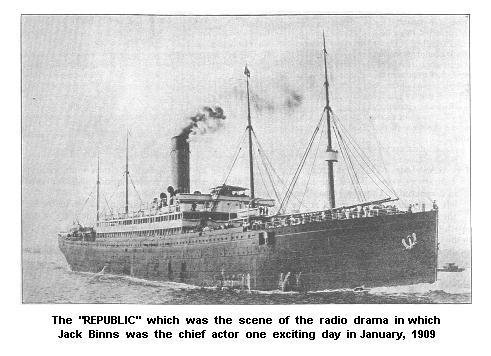
Awakened by the sudden change in the fog signals,
Binns sat upright on the edge of his bunk, and listened, One second, two
seconds, three----
A tremor ran throughout the ship.
There was terrific crashing. Rushing from his bunk into the operating room which
was situated on the aft-port side of the ship, he peered out through the
darkness.
Crumpled up like the bellows of a
concertina, the lower part of the colliding ship's bow had hit the
Republic full and square in her engine room compartment while the upper
part, plowing its way through the cabins on the deck, hung over it, a menacing
mountain of twisted steel. The roof of the wireless cabin collapsed; part of the
cabin itself was wrenched away.
A strong current was
running, swinging the colliding ship and the Republic around and twisting
her davits, stanchions and beams. The telephone between the wireless cabin and
the bridge was destroyed. At a glance--it all happened at once, it seemed--Binns
took in the situation. He was standing between life and death. Unlike many
others on the ship his intelligence was not numbed. He got into action.
Was his wireless set in working order? Was the
antenna intact?
"The system we used at that time
enabled me to find out very quickly," said Mr. Binns, when the writer
interviewed him in his office at the New York Tribune. "I had a
transmitting apparatus consisting of a ten-inch spark coil which was run from
the ship's lighting mains and could be used either for untuned sending at the
natural period of the aerial or with a tuned circuit which was an inductance and
condenser of Leyden jars. On the other hand, my receiving equipment consisted of
a magnetic detector with a Franklin tuner which was one of the new pieces of
apparatus of that day. But, judged from present standards, that tuner was very
crude.
"We were transmitting with what is known as
plain antenna, and unless the antenna was up and throughly insulated, it was
impossible to get a spark. I had just time enough to work the key and find out
that the antenna was still up when the lights went out. All the machinery of the
ship, including the generators, had been almost immediately put out of
commission.
"I had jumped to the key immediately--I
think that not more than three seconds had elapsed since the vessel had struck
us. Although I had a vague idea what had happened, I didn't know the exact
details. What I did know was enough. As the vessels were swung around by the
current I saw my cabin being ripped away.
"When the
ship's lighting current went off, I changed over to our storage batteries for
transmission power. We carried these batteries as an emergency reserve. When we
used the batteries to operate the spark coils, our range was limited to
approximately sixty miles. It was still dark and foggy. The air was biting cold.
I put on as many clothes as I could find, bundled an overcoat around me, and
began sending out CQD, which at that time was the distress call. 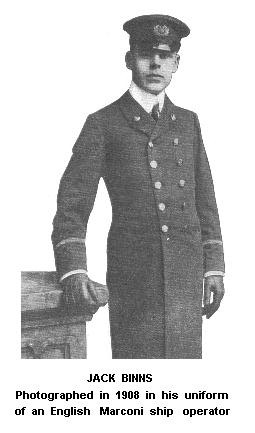
C Q D
THERE was little on the air at that time of the night. We were,
as I found out later, about sixty miles away from the Siasconsett station on
Nantucket Island, just on the verge of communication with the shore and that was
all. It seems that Jack Irwin, the man on watch at Siasconsett, had had a very
quiet night and had dozed off to sleep. As a result his fire had died down and
presently he began to feel uncomfortably cold. He woke up with a start so
suddenly, in fact, that he became wide awake. He was just in the act of putting
on more coal when he heard my call. He dropped the coal, jumped over to the key
and replied instantly. I told him we were in distress, that two vessels were in
distress, that I did not know at that moment where we were, nor the extent of
the damage to either one of us, but told him I would get the information from
the bridge as rapidly as possible, and asked him to keep everybody off the air
until I could get the information through. However, I had no sooner sent this
message than I received word from Captain Sealby, giving the damage done by the
collision and the position of the ship. When I conveyed this message to
Siasconsett, Irwin immediately sent out a general distress call. The steamship
Baltic of the White Star Line was the first to answer the call.
"During this time we were drifting. The captain had
absolutely no control of the ship. We had found the vessel which struck us, and
learned that it was the Italian steamship Florida with immigrants bound
for New York. She had not suffered as much as the Republic, and it was
decided to put all of our passengers and crew on board her. Her engines were
undamaged and the ship was controllable. But transferring the passengers from
the Republic was not an easy task, for the Florida was a very
small ship and had nearly 2,000 passengers on board, the majority of them being
refugees from the earthquake at Messina, in Italy. The captain of the Italian
ship, a young man by name of Ruspini, handled the situation from his end with a
surprising degree of coolness.
"About noon of that
day--which was Saturday--the Baltic was within ten miles of the
Republic. I could tell by the strength of her signals, although at that
time we had no means of knowing definitely how far away any particular station
or ship was, and I had to rely on the sensitiveness of my ears to arrive at that
conclusion.
EIGHTEEN HOURS CONSTANT DUTY
AT THE KEY
THE fog had, if
anything, grown worse than it was at 4.00 o'clock that morning--and of course
the Baltic had to reduce speed for fear of running into us before she
could check her speed. From twelve o'clock until six in the afternoon I remained
constantly at the key trying, in conjunction with the officers of both ships, to
get the Baltic alongside. To accomplish this we exploded detonating bombs
and fired sky rockets. When one ship exploded bombs, the officers on the other
would try to learn approximately the direction from which the sound came. We
were doing this all afternoon on both ships, but although we were within an
approximate radius of ten miles of each other, none of the explosions had been
heard.
"Six o'clock came and it was still foggy and
dark. Presently we had reduced the number of our bombs to where each of us had
only one left. According to our soundings, we were aware that the
Republic had been sinking steadily at a rate of about one foot an hour.
Unlike the sound of the voice or other noise, wireless of course was not
directional, and inasmuch as we had no electrical means of determining the exact
location of each other we might just as well have been a thousand miles apart.
"At this point we checked up, carefully with each
other the time on our chronometers. Each ship carried three chronometers, the
mean average of which was taken as the accurate time. As soon as we had checked
up on that it was decided that the Republic should fire her last bomb at
a certain precise second, and they would listen very attentively to hear it.
That second arrived, and Boom! went the bomb. But it proved in vain--they did
not hear it. It looked like a forlorn hope. The Republic was gradually
sinking, night had come upon us, the Florida was floating somewhere in
the neighborhood fearfully crowded with four thousand passengers and crew aboard
that small ship. What were we to do?
"We made
arrangements for the Baltic to explode her last bomb, and then I went
forward on the bridge, By this time there were only eight on board the
Republic. We had plenty of time, so seven of us formed ourselves in a
circle with our faces outward while the quartermaster stood by the chronometer.
He was to indicate to us by moving his arm upward the exact second the explosion
of the last Baltic bomb was to take place. He raised his arm and--we
listened.
"An operator's sense of hearing
undoubtedly becomes more acute than another person's because of his constant
training in straining his ears for faint code signals. Somehow or other, within
about five seconds after the quartermaster had raised his arm, I heard very
faintly what I thought might be the sound of a bomb. I turned to the third
officer who stood next to me and he said he thought he had heard it too,
although he wasn't exactly sure. It had been prearranged that none of us were to
move in case we heard the sound, this in order that we could check the direction
and get our bearings on the Baltic. Consequently, the officers took a
bearing on the direction the sound came from, according to the third officer's
and my own sense of hearing, and then I went back to the operating cabin to
transmit steering directions to the Baltic, based on those bearings. We
cautioned them to come very slowly because of our helplessness. 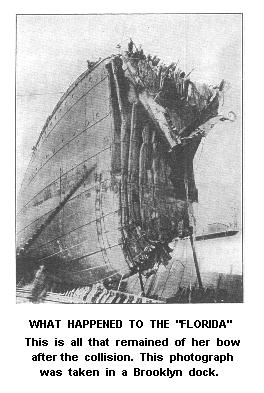
"Had we
really heard the Baltic's last bomb? Were the steering directions I had
just transmitted going to bring her alongside? Those were tense moments.
"In about fifteen minutes we heard the fog horn of
the Baltic. The last bomb really had been heard beyond all doubt.
"'You are proceeding on the right course, was the
message that I then sent the Baltic. 'We can now hear your fog horn. Come
very cautiously as we have no lights.'
"And then,
fifteen minutes later I heard a tremendous cheer. I knew of course that it
couldn't come from the members on our own ship, as there were only eight of us.
I looked out of the cabin. There was the Baltic coming up right alongside
of us. Her passengers had lined the decks to keep a sharp lookout for us.
"It was then a little after seven o'clock Saturday
evening. It had taken fifteen hours of the most trying and intensive work to
bring the Baltic alongside during the dense dark fog, and considering the
crude apparatus we had at that time I have always considered it a great
achievement, for a more difficult set of circumstances could hardly be imagined.
"After our officers conferred with Captain Ranson of
the Baltic, she proceeded to where the Florida lay, as Captain
Sealby felt very anxious about the safety of his passengers, especially since
the Florida was badly damaged and excessively overloaded.
"Just about this time the fog suddenly lifted and
the weather turned into a nasty driving rain. The Baltic found the
Florida and the combined crews of the ships immediately set about
transferring all the Republic's and Florida's passengers to her
own decks. Throughout the night in the cold, drenching rain these crews labored
transferring 4,000 passengers through a dangerous long rolling swell. Thus
within the short space of twenty-four hours there had been two major transfers
of passengers at sea, and all accomplished without loss of human life.
And when daylight broke the next morning, Sunday,
there was one of the greatest concourses of ships ever seen on the seas.
Everywhere, as far as the eye could see were ships. Every liner and every cargo
boat equipped with wireless that happened to be within a three hundred mile
radius of the disaster, overhearing the exchange of messages between the
Baltic and Republic had gathered around and stood by ready to be
of whatever assistance they could. It was a fine testimonial to the value of
wireless. Shortly after daybreak the Baltic proceeded to New York and the
Florida also proceeded at slow speed, convoyed by two or three other
ships that were standing by. And then relief ships cared for the badly damaged
Republic.
"During all this time, of course,
the Republic, had been slowly sinking, and it was decided to tow her into
the shallow waters off Nantucket. Two revenue cutters, the Gresham and
Seneca, thereupon took line on the bow of the Republic in tandem
fashion, and the Anchor Line Furnessia tied up on the stern to act as a
rudder for the disabled ship. All available means were taken to keep her afloat.
The tow started at ten o'clock Sunday morning and continued until seven o'clock
Sunday night, but no actual progress had been made for although the revenue
cutters pulled her forward, a cross current was running against them at
practically the same speed, so that all four ships virtually stood still.
"Finally the Furnessia cast off, for the
stern of the Republic was under water. The water was already beginning to
creep into my cabin and while I was wondering whether I should go forward or
wait until the captain sent for me, the third officer came aft and said the
captain had issued orders to get ready to abandon the ship and that I was to
come forward. I didn't hesitate about that. The rest of the officers were there
and we tried to persuade Captain Sealby to abandon the ship with us. But he
refused to do so. Instead he asked for a volunteer to stay with him. Everyone
volunteered. Captain Sealby then chose Second Officer Williams on account of his
being the senior unmarried man in the group and also because Williams knew the
Morse code and could signal with a lantern. 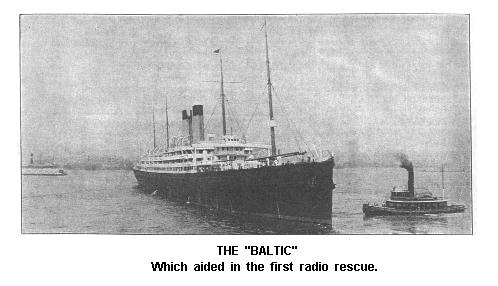
"At this time the
Republic was attached to the Gresham by a steel hawser. As soon as
we put off in the Captain's gig we pulled over to the Gresham, told the
captain of that ship the condition of the Republic, and asked him to pay
out a nine-inch rope hawser and stand by, ready to cut the rope hawser as soon
as he got a signal from the bridge of the Republic that the ship was
about to go under. It had been previously agreed that Captain Sealby was to
flash a blue Coston light when that moment did arrive. This the captain of the
Gresham did. He stationed a man with an ax over the hawser, with
instructions to cut it the moment he saw the blue light. We stayed off in the
life boat waiting for developments and holding ourselves ready to go to the
rescue of the Sealby and Williams the moment the ship went down.
"Fortunately there were four or five other ships in
the vicinity watching the proceedings. Each one played its searchlight on the
Republic. By the aid of the many searchlights the two lone figures could
be seen pacing to and fro on the uptilted bridge. And then came the signal of
the blue light. Then we saw one of the men jump on to the rat-lines of the
foremast, climb up to the top of the mast and wait. The other man ran forward,
climbed up on the rail, and taking one last long look at the little cabin on the
bridge turned and dove forty feet into the sea.
"For
one minute more the bow of the Republic trembled above the waves and then
sank.
"We rowed over to the spot where it went down.
The light of each observing ship was trained upon the spot. Fortunately a quiet
sea was running at the time, but even so it was most difficult to see very far
from the open boat as the lights, intercepted by the crests of the waves, threw
darkened shadows over most of the surrounding waters. We grew very anxious about
Captain Sealby and Mr. Williams, for certainly no man could long survive the
cold of those wintry waters.
"For twenty minutes we
rowed around, earnestly but yet aimlessly, for we did not know where to go. On
all sides we saw the glaring searchlights--but nowhere could we discern any sign
of life in the sea. I don't think any more sorrowful moment ever came into the
lives of the men in that open boat, not to mention those on the nearby ships,
for Captain Sealby and Second Officer Williams had nobly upheld the tradition of
the sea. But the length of time did not diminish our hopes.
"This collision at sea had indeed brought forth a
series of climaxes. First the wireless apparatus, crude as it was, had brought
Siasconsett to our aid; the very last bomb that the Baltic had came
within an ace of being in vain, and now--
"Suddenly,
to our right, from out the murky blackness of the waters of the sea, a revolver
shot rang out. We pulled over in that direction immediately, and there we found
Captain Sealby hanging on to a floating crate, so nearly exhausted that he had
had just sufficient strength to pull the trigger of his revolver. 'Williams over
there', he said, 'Get him.' But we pulled the captain in then and there, and
then rowed in the direction he had indicated. And sure enough we found Williams
too, clinging to a hatch cover that had floated off the Republic when she
went down."
It was fitting denouement to one
of the greatest near-tragedies of the sea. And a tragedy indeed it would have
been had it not been for wireless and an operator who had initiative, skill, and
the fortitude to stick to his post for 48 hours without eating or sleeping. 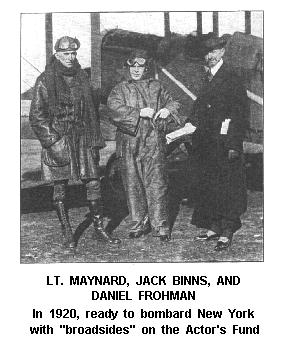
Jack Binns was born in Lincolnshire, England, in
1884. Early in his teens, he became interested in the electrical sciences and
attended the technical school of the Great Eastern Railway, where he obtained a
thorough grounding in electricity and learned the Morse telegraphic code. About
that time Marconi, having made his bow to the scientific world, was developing a
company over in England. Binns made application for a position as operator and
was quickly accepted. He became connected with the Belgian Marconi Company and
was sent to sea on a German ship.
At that time there
was competition between the Marconi system and the Slaby-Arco system, a German
system in use on German ships, but the Marconi organization was better developed
and they won out. About twenty operators were picked for service on German
ships, Binns among them, and during his connection with that company he did
considerable experimental work, chiefly in long distance reception from the
so-called high power stations at that time--the Poldhu and Cape Cod stations.
This experimental work took him not only across the Atlantic but up around
Spitzbergen in the Arctic Ocean and down in the tropics on this side of the
Atlantic, through the Caribbean Sea and along the northern coast of South
America, all of which work was in addition to regular trips made as operator on
German ships.
About 1907 there was a great deal of
agitation in Germany over the presence of foreign operators on board German
vessels, who included not only Englishmen but Americans, Italians, Belgians,
Danes, and even one Icelander. Consequently, in June, 1908, the German
Government notified La Compagnie de Telegraphie Sans Fil (Belgian Marconi
Company) that all foreign operators would have to be replaced with German
operators by the end of July that year. In August of that year, the German
Government precipitated the second Morocco crisis. In its order, the German
Government bluntly stated that in the event of war with Great Britain or any
other European power the foreign operator on board a German ship would
undoubtedly refuse to notify the commander of the fact that war had broken out
and consequently those ships would be captured by enemy cruisers. Therefore,
Binns was among the operators replaced, and after one or two shifts to various
positions with the Marconi company, was assigned to the steamship
Republic which post he had held for a period of three months.
During the war years, he became so proficient in
flying that he was engaged as instructor in the Canadian Flying Corps, and made
his headquarters at Toronto. Here he taught not only piloting, but instructed
aviators in radio and the code. Radio indeed has been the outstanding feature of
his life's work. He was one of the first to prove its value in an emergency at
sea. He was one of the organizers of the New York Newspaper Club, and is now the
Radio Editor of The New York Tribune.




